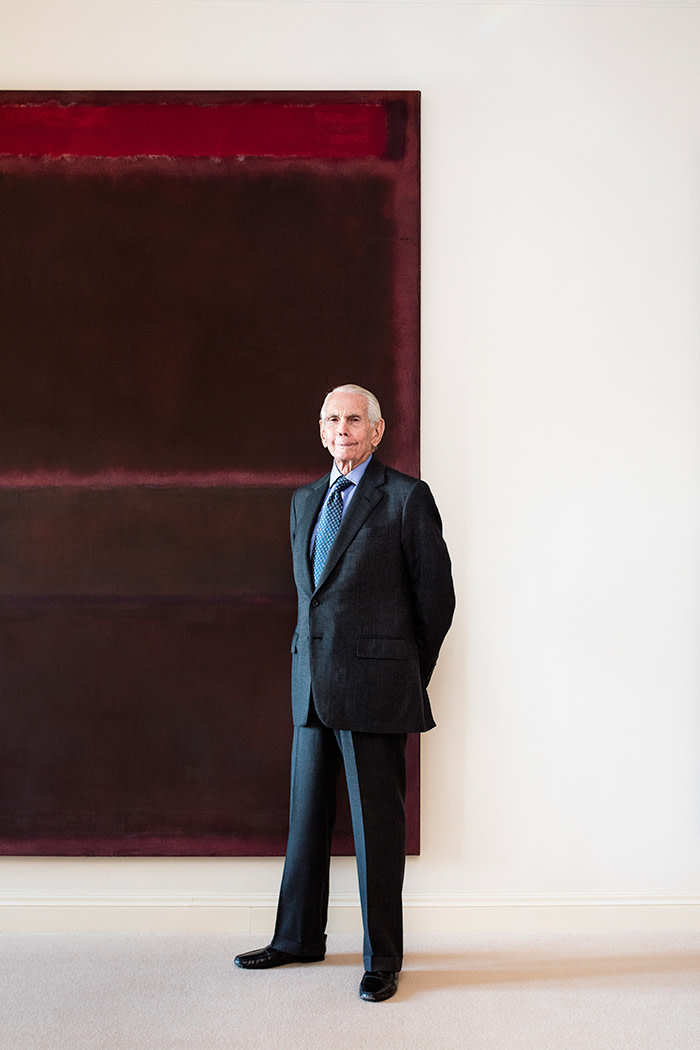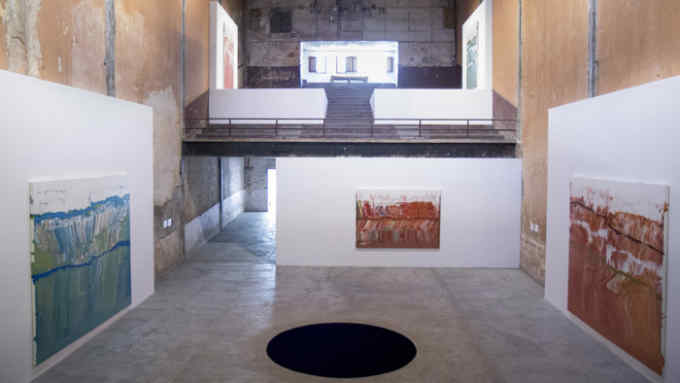Art collector Donald Blinken remembers all about artists

Simply sign up to the Life & Arts myFT Digest -- delivered directly to your inbox.
In a time when a painting by Mark Rothko can sell for $86.9m, it’s hard to imagine a decade when there were so few people in the New York art world that a beginning collector could not only afford a Rothko, he could meet him. And buy great paintings directly from the artist. And, best of all, become his friend.
As a young New Yorker in his 30s, I had no thought of assembling a collection that would include important pictures by, among others, Mark Rothko, Willem de Kooning and Philip Guston. In the early 1950s, I was living in London, just beginning to look at paintings in the homes of my British friends. And I haunted the Tate Gallery, which owned wonderful early 20th-century paintings by Picasso and Matisse, among others.
When I returned to New York, I began to visit the few New York galleries showing contemporary art. One of these dealers, André Emmerich, hosted collectors, painters, dealers and critics on Saturday afternoons at his apartment. There, in September 1956, I met Mark Rothko.
Rothko was the quintessential New York artist. His friends were artists, writers and musicians; their conversations tended to be intellectual and philosophical. Although he could often be found in museums, studying both Old Masters and recent art, he was ambivalent about museum shows of his own work. He had misgivings about commentary on his work, collectors’ motives, and much more.

I didn’t know that Rothko jealously guarded his studio and was notorious for not welcoming visitors. But when I introduced myself and said I’d like to visit his studio, he didn’t snap. After he looked at me for a moment, he said, “Well, if you bring that blonde you’re with, you can come.” A few weeks later, when I knocked on the door of his studio, I didn’t bring the blonde, but he let me in anyway.
Rothko’s studio had high ceilings, sliding racks for his paintings, a few chairs and a sofa. We chatted for a bit, then he brought out four or five paintings. I was immediately struck by “Three Reds” and said I’d like to have it. The business conversation took 10 seconds. “You send the money to Sidney Janis,” he said, “and I’ll have the painting shipped to your home.” This was the template for every purchase I’d make with New York School artists — I’d ask the price, they’d tell me, and I’d agree.
The Rothko arrived a week later. Looking at it among the French, Italian and British artists in my collection, I realised something would have to change. Within a year, they were all gone. And I began to look seriously at other New York School painters.
What was Rothko like? Very serious, almost professorial, but not anxious to talk about his art. Rather, he philosophised and discussed the world in general. When it came time to hang two of his paintings, he came to my new apartment. Was there anything I could do for him while he pondered? “Yes. Put on some Mozart opera.” I did, and we hung his paintings to The Marriage of Figaro.

Some years later, Rothko became depressed by illness, marital problems and his feeling that Pop Art was taking over the art scene. I was aware of all this, but I was stunned by his suicide in 1970. In the 14 years I knew him, he was an agreeable dinner companion, absorbed in his work, where his pictures went and how they were looked after by a burgeoning number of collectors.
A few years after his death, the Rothko Foundation became the focus of the art world’s biggest scandal. Headed by Rothko’s dealer Frank Lloyd and his accountant Bernard Reis, the Foundation had obtained 798 of Rothko’s paintings and other works at bargain-basement valuations and was reselling them at severely marked-up prices. After a lawsuit and an eight-month trial, New York State removed the Rothko executors and extracted $9.2m from them — a devastating judgment for Reis and Lloyd. The initial Foundation was terminated, a new one was established, and I was named president. By 1976, the Foundation had received five-ninths of the Rothko estate. Before we closed up shop in 1986, it gave away 1,000 works to 29 US and six foreign museums, including several hundred works to the National Gallery in Washington DC — a very satisfactory ending.
I visited Philip Guston’s studio for the first time in 1956 and acquired his lyrical painting “Cythera”, a tribute to the famous Watteau in the Louvre. Of all the artists I came to know, Guston was the most interesting and vivacious conversationalist. It was a pleasure to listen to his reminiscences and descriptions of the art world and the political scene. He and my wife Vera had a common birthday, and much more. Both considered Piero della Francesca to be their favourite artist, and “The Flagellation of Christ” their favourite painting. These happy coincidences led to our spending several joint birthdays with Philip and his wife Musa.
In 1973, during a birthday lunch at Guston’s Woodstock home, he was agitated by an attack by the critic Hilton Kramer on his new paintings. Kramer claimed that Guston had abandoned abstraction for an almost cartoon-like figurative world. We hadn’t seen these paintings. We asked if we could. Philip didn’t like to show new work, but several glasses of wine had been consumed, which enabled us to persuade him to let us into his studio. There we found the magnificent, just finished “Painter’s Table”, which represented many of the objects in his studio: an overhead bare light bulb, a green window shade, the old-fashioned hand irons he used for smoothing canvases, dishes of paint and brushes, an ashtray, and references to the spikes and blood in “The Flagellation of Christ”. We were immediately struck by this great work and purchased it on the spot.

The acquisition of “Study for Pink Lady”, a 1948 de Kooning, was more unlikely. It started with a phone call from the painter Jack Tworkov, who often suggested artists I should be looking at. On this day in 1958, he reported that, “Greenbaum, the dentist, is getting a divorce.” This was art world news because Greenbaum did dental work for artists in exchange for paintings and had amassed a fine collection of smaller works by leaders of the New York School. Now the Greenbaums were ending their marriage, and they’d decided to sell everything and split the money. I promptly went to Greenbaum’s office — and there was the lovely de Kooning. It’s reproduced in all the de Kooning catalogues; in many ways, it’s the most romantic of his paintings of women.
I had another occasion to acquire an important de Kooning, this time for the Whitney Museum. On a snowy day in 1960, I went with David Solinger, the chairman of the Friends of the Whitney Museum, to de Kooning’s studio. Leaning against a wall was “Door to the River”, a superb yellow-and-pink picture with a mysterious door in the centre. We asked Bill what he was planning to do with it. His response was touching: “It’s a legacy for my daughter.” As we were representing the Whitney, neither of us could buy the picture for ourselves, and we had the same thought: this picture really belongs in a museum. “‘Door to the River’ is too important to hide for years as a future gift,” we said. “We’d love to have the Whitney acquire it.” De Kooning wasn’t sure he wanted to part with it, but a week later, he let us know that, yes, he was prepared to sell. We asked the price. It was $19,000. Jack Baur and Lloyd Goodrich, the two professional directors of the Whitney, resisted: “$19,000? That’s more money than we can afford.” In that case, we said, the Friends of the Whitney would put up half if the Whitney would put up the other half. And the Whitney acquired one of the finest paintings in its collection of postwar pictures.
I was in my early 30s when I started collecting the New York School. The artists weren’t like me, just starting to make a mark; they were middle-aged, in mid-career. In the new world capital of contemporary art, these important artists actually enjoyed sharing their ideas with a beginning collector. Living with their art for six decades has been a pleasure, but the experience of visiting artists’ studios and talking about art — that was an enriching, privileged education, briefly available then, perhaps impossible now.
Follow @FTLifeArts on Twitter to find out about our latest stories first. Subscribe to FT Life on YouTube for the latest FT Weekend videos
Photographs: Nicholas Calcott

Comments